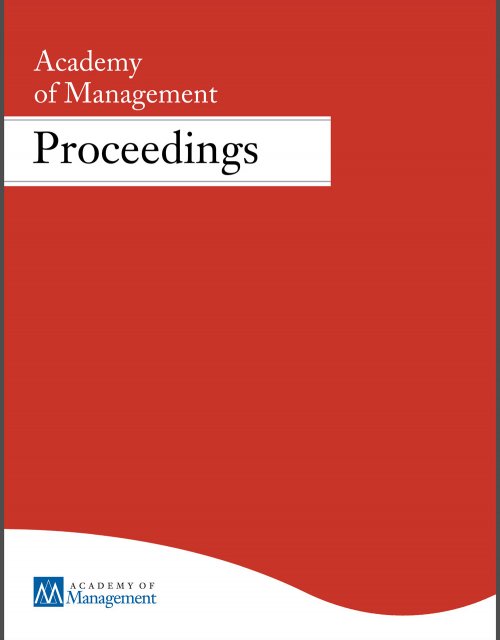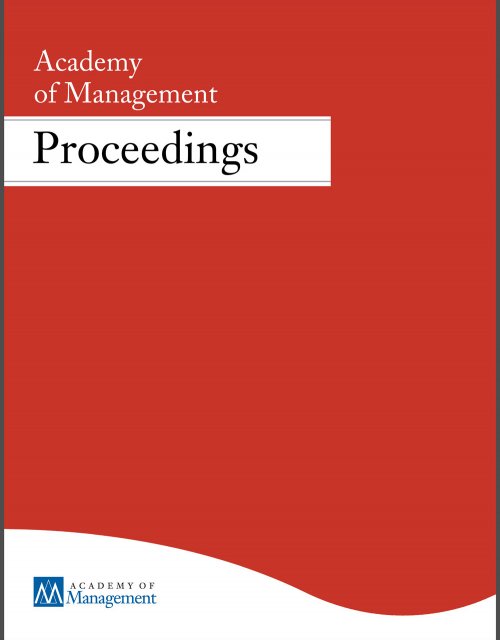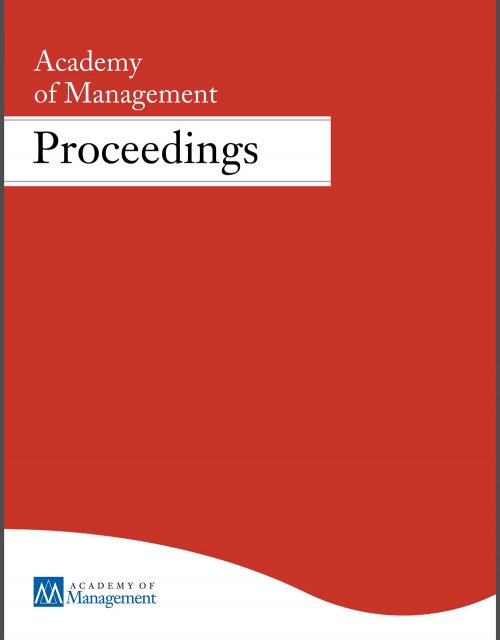Publication records
Inventors recombine existing knowledge elements to identify new technological solutions and novel inventions. We study how inventors’ reliance on different sources of knowledge, their personality traits, and the diversification of the organizational knowledge of their employers jointly determine recombination outcomes. In our theorizing, we distinguish inventors’ overall recombination success from the share of technologically novel recombinations. Our predictions are tested relying on a large-scale survey of 1,327 industrial inventors, enhanced with patent-based measures of recombination outcomes. The results confirm earlier findings that access to a diverse set of knowledge is positively related to both recombination success and the rate of novel recombinations. Further, we are able to show that this clear relation holds only for inventors employed by firms with low knowledge diversification. Finally, personality dominates the effect of inventors’ reliance on different sources of knowledge and is relatively more important.
With permission of the Academy of Management
Volume
2021
ISSN (Online)
2151-6561
ISSN (Print)
0065-0668
The assumption that better performance today predicts better performance tomorrow pervades nearly all behavioral theories of learning from experience in organizations. Because of the widespread reliance on the higher-is-better heuristic, theories predicting performance non-monotonicity---higher past performance generating lower future performance---are of long-standing interest in management theory and economic sociology. The extent of real-world violations of the higher-is-better heuristic is, at its core, an empirical question. However, there is very little research testing the higher-is-better assumption, despite its ubiquity in organizations and markets and the panoply of mechanisms detailing when it might fail. In part, the lack of empirical research on this very important question is driven by the weaknesses of existing methods for detecting non-monotonic relationships in data. The method applied here, which adopts a "shape constrained'' approach to statistical inference, avoids the well-known problems of testing non-monotonic associations in commonly-used methods based on linear regression. Our paper empirically tests the hypothesis of performance monotonicity in 12 datasets across four commonly-studied domains. Performance monotonicity is rejected in eight out of the twelve datasets examined and at least one dataset in all four domains demonstrates a non-monotonic performance pattern.
With permission of the Academy of Management
Volume
2021
ISSN (Online)
2151-6561
ISSN (Print)
0065-0668
Subject(s)
Diversity and inclusion; Human resources management/organizational behavior; Strategy and general management
Keyword(s)
Organizational inequality, M&A, gender, cultural norms, careers, wage gap
Extant literature in organizational inequality shows that environmental forces affect firm gender equality outcomes. While there is evidence that national gender culture affects individual economic outcomes, little is known about the influence of national gender culture at the firm-level. In this article, I use the context of cross-border acquisitions to study how national culture shapes firms’ arrangements towards gender equality as I explore how foreign acquisitions affect workplace gender equality at acquired firms. I use restricted-access employer-employee data from France matched to M&A data. I use a generalized differences-in differences approach to estimate the impact of acquirer national gender culture on gender equality outcomes at acquired firms after an acquisition. I find that firms acquired by acquirers from more gender egalitarian countries see a larger increase in female representation in management and larger decrease in gender pay gap post-acquisition, compared to firms that get acquired by acquirers from less gender egalitarian countries. This main effect is stronger when the post-acquisition integration process is more thorough and when a new CEO is appointed at the acquired firm.
With permission of the Academy of Management
Volume
2021
ISSN (Online)
2151-6561
ISSN (Print)
0065-0668
Subject(s)
Diversity and inclusion; Strategy and general management
Keyword(s)
Chance models, adaptation, organizational learning, luck, situation, risk-taking
Chance models—mechanisms that explain empirical regularities through unsystematic variance—have a long tradition in the sciences but have been historically marginalized in management scholarship. An exception is the work of James G. March and his coauthors, who proposed a variety of chance models that explain important management phenomena, including the careers of top executives, managerial risk taking, and organizational anarchy, learning, and adaptation. This paper serves as a tribute to the beauty of these “little ideas” and demonstrates how they can be recombined to generate novel implications. In particular, we focus on the example of an inverted V-shaped performance association among the executives featured in one of the most prominent lists of executives, Barron’s annual list of Top 30 chief executive officers. A reanalysis of March and Shapira’s 1992 model provides a novel explanation for why many of the executives’ exceptional performances did not persist. In contrast to the usual explanations of complacency, hubris, and statistical regression, the results show that declines may result from these executives’ slow adaptation, incompetence, and self-reinforced risk taking. We conclude by elaborating on the normative implications of Jim’s chance models, which address many modern management and societal challenges. We further encourage the continued development of chance models to help explain performance differences, shifting from accounts that favor heroic stories of corporate leaders toward accounts that favor those leaders’ changing fortunes.
With permission of the Academy of Management
Volume
2021
ISSN (Online)
2151-6561
ISSN (Print)
0065-0668
Subject(s)
Economics, politics and business environment
Keyword(s)
Cartels, private damages, competition law
Private cartel damages litigation is on the rise in Europe since early 2000. This development has been initiated by the European courts and was supported by various policy initiatives of the European Commission, which found its culmination in the implementation of the EU Directive on Antitrust Damages end of 2016. This paper explores the impact of this reform process on effective compensation of damaged parties of cartel infringements. For that purpose we analyse all European cartel cases with a decision date between 2001 and 2015, for which we analyse litigation activity and speed. Overall, we find a substantial reduction of the time until first settlement (increase in litigation speed) together with a persisting high share of cases being litigated (high litigation activity). This supports the view that the reform not only increased the claimant’s expectation about the amount of damages being awarded, but also resulted in an alignment in the expectations of claimants and defendants in the final damages amount, i.e. the European Commission succeeded in reaching its objective to clarify and harmonize legal concepts across Europe.
Volume
9
Journal Pages
313–346
Subject(s)
Human resources management/organizational behavior
Keyword(s)
Crowdsourcing data analysis, scientific transparency, research reliability, scientific
robustness, researcher degrees of freedom, analysis-contingent results
robustness, researcher degrees of freedom, analysis-contingent results
In this crowdsourced initiative, independent analysts used the same dataset to test two hypotheses regarding the effects of scientists’ gender and professional status on verbosity during group meetings. Not only the analytic approach but also the operationalizations of key variables were left unconstrained and up to individual analysts. For instance, analysts could choose to operationalize status as job title, institutional ranking, citation counts, or some combination. To maximize transparency regarding the process by which analytic choices are made, the analysts used a platform we developed called DataExplained to justify both preferred and rejected analytic paths in real time. Analyses lacking sufficient detail, reproducible code, or with statistical errors were excluded, resulting in 29 analyses in the final sample. Researchers reported radically different analyses and dispersed empirical outcomes, in a number of cases obtaining significant effects in opposite directions for the same research question. A Boba multiverse analysis demonstrates that decisions about how to operationalize variables explain variability in outcomes above and beyond statistical choices (e.g., covariates). Subjective researcher decisions play a critical role in driving the reported empirical results, underscoring the need for open data, systematic robustness checks, and transparency regarding both analytic paths taken and not taken. Implications for organizations and leaders, whose decision making relies in part on scientific findings, consulting reports, and internal analyses by data scientists, are discussed.
With permission of Elsevier
Volume
165
Journal Pages
228–249
Subject(s)
Economics, politics and business environment; Information technology and systems; Technology, R&D management
Keyword(s)
Cybersecurity, information security, information law, critical infrastructures, cyber regulation
Two articles explain the genesis and contents of the German IT Security Act 2.0, which was enacted in May 2021. This first article focuses on the origins of the law, the obligations of companies as operators of information technology, and the new regulations on the security of IT products.
Journal Pages
450–458
ISSN (Online)
2194-4172
Subject(s)
Economics, politics and business environment
Keyword(s)
Decision biases, Sunk cost effect, Susceptibility scale, Cognitive ability, incentivized experiment
The sunk cost effect is one of the most well-known decision making biases. In this article, I describe how my co-authors and I developed an 8-item test comprised of hypothetical scenarios to determine the respondent’s susceptibility to the sunk cost effect. We validate the scale with an incentivized experiment. We also find evidence that experience, rather than smarts, which helps people to avoid falling foul of the effect.
ISSN (Print)
0017-8012
Subject(s)
Economics, politics and business environment; Finance, accounting and corporate governance
Keyword(s)
debt capital structure, bond debt, monetary policy, quantitative easing, universal banks, Glass-Steagall, central bank policy
JEL Code(s)
E00, G00, G20, G21, G28
This dissertation in the field of empirical financial economics broadly explores the interplay between monetary policy, debt securities markets and bank credit. Specifically, the three chapters of this dissertation share two major themes, debt capital structure and the effects of central bank policy. Chapter 1 studies a determinant of the corporate debt capital structure and it finds that the rise of universal banking conglomerates contributed to the increase in bond financing in the U.S. The article of Chapter 2 links the two themes by analyzing a mechanism that describes how the corporate debt structure influences the transmission of central bank policy to the real economy. When central banks purchase corporate bonds, purchase-eligible firms substitute bond debt for bank loans. This, in turn, frees up balance sheet capacity at banks that then start lending to firms without access to bond markets. Finally, chapter 3 is based on an article that examines to what extent central bank policy, among other causes, may be responsible for the low interest rates in recent years. It also analyzes the consequences of low interest rates and issues policy recommendations.



